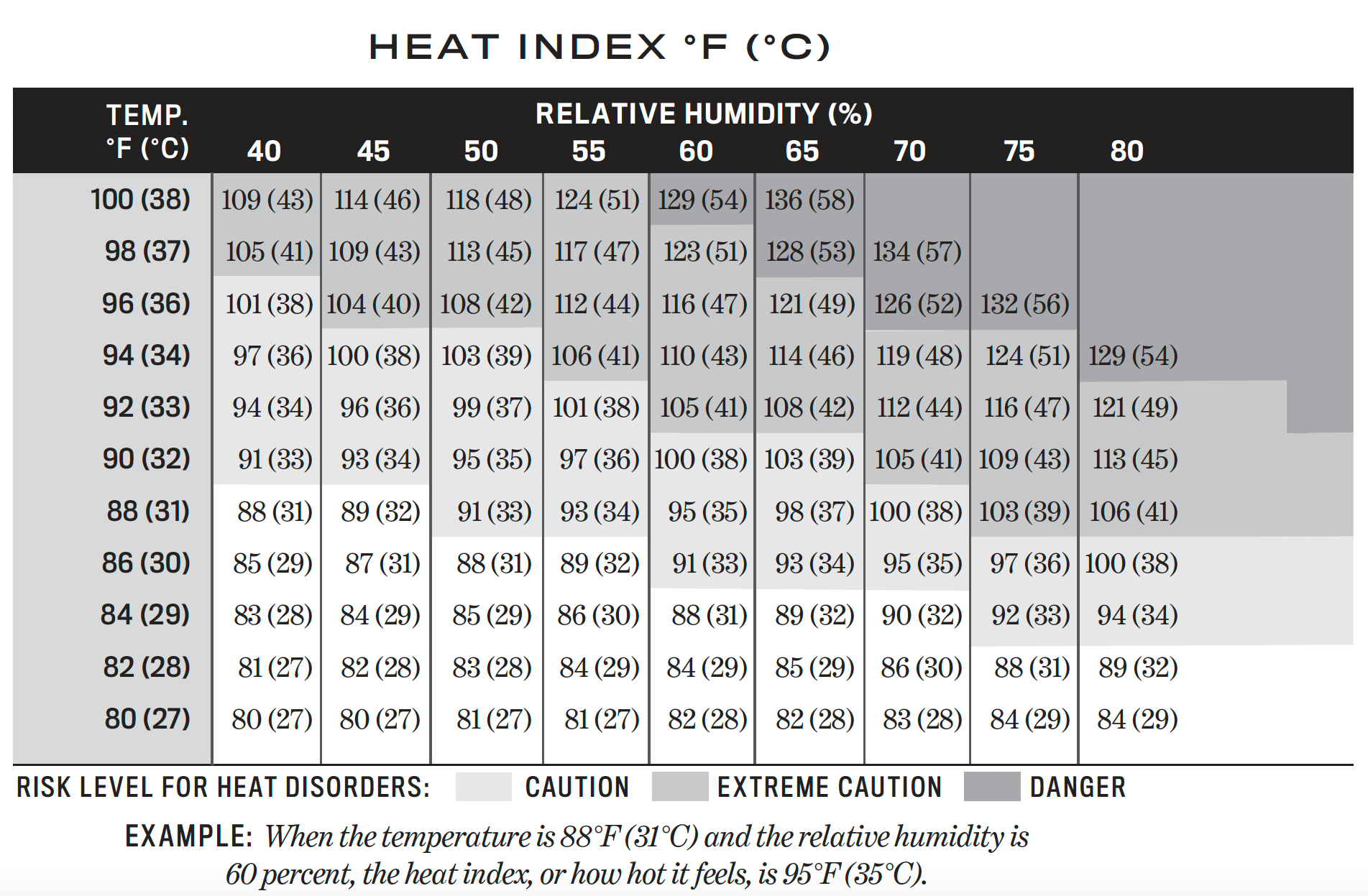Feeling the heat—or is it just the humidity? Find out for sure with our Heat Index Calculator! Just enter the air temperature and humidity, and you’ll get the “feels-like” temperature in seconds, plus your heat risk level. It’s the easiest way to know whether it’s a perfect day for gardening or more of a “hide in the A/C with a tall glass of lemonade” kind of day.
Heat Index Calculator
What is the Heat Index?
Ever wondered why it feels so much hotter than the thermometer reads? That's called humidity.
The Heat Index is closer to how it really feels outside, since it measures not only temperature, but also how hot it feels when humidity is factored in with the actual air temperature. The Heat Index is also called the "felt air temperature."
For example, the heat you feel when the actual temperature is 90ºF with a relative humidity of 70% is 105ºF.
Sometimes, when it's extremely humid, it doesn’t need to be that hot outside for the weather to be harmful. Dry heat can also be dangerous because the body can only handle so much heat. The combination of high temperature and high humidity reduces your body's ability to cool itself.
Heat is the top weather-related killer, causing more fatalities than lightning, tornadoes, and hurricanes combined.
Heat Index Chart
NOAA (National Oceanic and Atmospheric Administration) will issue heat alerts based on Heat Index Values. Pay attention to heat-related watches and warnings when they are in effect.
The math equation is very long, so the NOAA created a simple chart (below). It's fairly easy to follow. For instance, if the air temperature is 96°F and the relative humidity is 65%, the heat index—how hot it feels—is 121°F. The Heat Index assumes shady conditions with a light wind since it's important to be in the shade during high heat.
When the index measures anywhere from 103° to 125°F, experts label it as dangerous heat. The darkest grey area below indicates extreme danger. Such temperatures carry a higher risk for heat stroke, exhaustion, and heat disorders.
The National Weather Service will issue alerts when the Heat Index is expected to exceed 105° to 110°F (depending on local climate) for at least 2 consecutive days.

Extreme heat strikes for a number of reasons. El Niño, a Pacific weather pattern, increases global temperatures. A warming climate is another reason for the rising heat. Over the past 30 years, summer temperatures have increased.
To practice heat safety, review this checklist:
What To Do When Heat Index is High
Drink More Fluids
- Drink more fluids, regardless of your activity level. Don't wait until you're thirsty to drink. Bring a reusable water bottle with you to maintain hydration. If you're at work, you could bring a drinking glass and pitcher and fill it every morning.
- If you're older, be especially careful to drink fluids because the amount of water retained by the body decreases with age.
- Avoid salt tablets, if possible. If your doctor has you on water pills, ask him or her how much you should drink.
- Don't drink liquids with dehydrating caffeine, alcohol, or large amounts of sugar. Avoid very cold drinks.
- At family events and reunions, bring a cooler of cool drinks.
- Cut back on exercising on hot days; if you must exercise, drink two to four glasses of cool, nonalcoholic fluids each hour.
Keep Your Body Cool
- Dress in lightweight, light-colored clothing and sun-reflective shirts. Wear loose clothing.
- Wear wide-brimmed hats and sunglasses. Keep a stash of hats on hand for friends and family!
- According to the Centers for Disease Control and Prevention (CDC), fans may provide comfort, but they do not prevent heat-related illnesses when the temperature is in the high 90s. Take a cool shower or bath, or move to an air-conditioned place to cool off.
- Stay inside, or stay in the shade, especially between 11 A.M. and 3 P.M.
- Avoid outdoor exercise during the heat of the day.
- Never leave anyone in a parked vehicle with the windows closed or open.
- To feel cooler, eat cooler. Reduce your protein intake.
- Open your house to the breeze after sunset and leave it open until dawn.
- In the early morning, draw the shades before the temperature starts to rise.
Protect Yourself From the Sun
- Avoid direct sunlight when the heat index is high.
- Don't get sunburned, which makes it difficult for your body to dissipate heat.
- In addition to a hat and sunglasses, wear sunscreen SPF 15 or higher. The most effective products say "broad spectrum" or "UVA/UVB" on the label.
Stay Alert
- Be aware of heavy sweating, hot and dry skin, rapid pulse, pale or clammy skin, and/or cramps in your leg or abdomen muscles. All could be signs of heat disorder.
- If you are older, it's wise to keep medical information readily available, including phone numbers of health care providers and copies of your prescription and health insurance cards.
To see guidelines on how to respond to heat disorder symptoms, go to the NOAA Website.
Comments